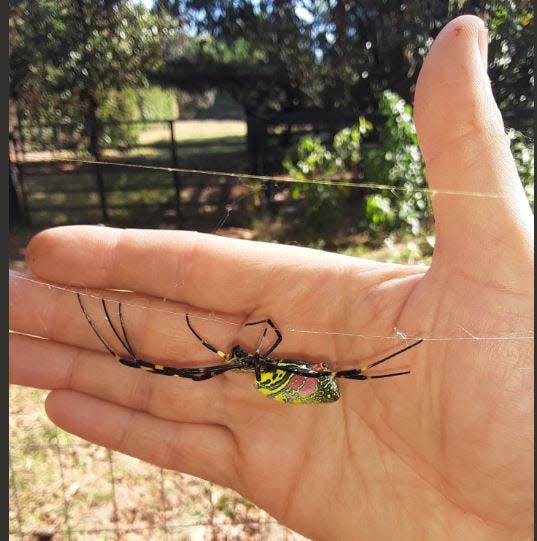New Joro spider study at UGA shows spider adapts easy to urban life and is on the move
A new study at the University of Georgia Odum School of Ecology shows that the invasive Joro spider can easily adapt to busy urban areas. The study bolsters the prediction that the Joro will spread to vast areas throughout the United States from their original foothold in Georgia.
“There really is no stopping them. It’s getting everybody’s attention and that’s a good thing and a bad thing,” said Andy Davis, an assistant research scientist in ecology, who authored the paper that was recently published in Athropoda, a journal for peer-reviewed scientific articles.
The Joro spider, native to eastern Asia, was first discovered in the Athens area in 2014, and since that time it has spread into Tennessee, both Carolinas and Alabama.
The carnivorous female Joro has a mature body glazed with yellow, green and red coloration that is over an inch long with metallic-looking legs protruding from its thorax. It weaves a wide haphazard web to trap and kill its prey.

What disturbs Joro spiders?
This new study on the Joro was conducted by Davis and three of his ecology students − Kade Stewart, Caitlin Phelan and Alexa Schultz.
“They did a lot of the grunt work. They were on the sides of roads collecting the spiders and looking at their behavior,” Davis said.
“The students did it for a class project they took from me last fall,” Davis said, adding this is the time when Joros are most noticeable as they reach a mature size.
Spider watch: Joro spiders are spreading in the Southeast and UGA scientists want your help to find more
The students located Joros along 20 roads of various traffic density in Clarke, Oconee and Madison counties, all of which have high populations of these spiders, according to the study. Due to vibrations created by traffic, the students recorded data that would show how these spiders reacted to highway disturbances.
Auditory and vibrational disturbances can cause behavioral changes for many animals, according to the study.
Once the students recorded the spider’s behavior to vibrations, the spider was plucked from its web, weighed, then released. The students tested and collected 359 spiders.
The study determined that Joros attacked simulated prey 65% of the time along low traffic roads and 51% next to moderate to high traffic roads.
Are Joro spiders scary?
The three students were engaging with a creature that often scares people.
“After a few attempts you get used to it and it became fun, honestly,” said Stewart, a Loganville Christian Academy graduate. “You learn to appreciate other field researchers. It’s not simple and easy work, and there is a lot of trial and error to figure out the best way to do things.”
Stewart, majoring in ecology and plant biology, noted that dealing with spiders in general is a little scary, especially large ones like the Joro.
Schultz, from Dayton, Tenn., and an ecology major, said she was excited about the project.

“I’ve always dreamt of doing field work,” she said. “But like Kade said, it was a little scary to deal with spiders on my first field experience.”
“We persevered through the heat on roadsides, capturing spiders and weighing them,” said the graduate of the International School of Basel in Switzerland. “I think we learned a lot because we don’t know much about the Joro spider.”
The Joros, because they are big and show up around homes in large numbers, have attracted a lot of attention from the public in northeast Georgia.
Are Joro spiders on the move?
Just last year, Davis had a study published that indicates the Joro is basically a shy and unaggressive spider, another factor that allows them to be tolerant of urban conditions.
“There is one upside to all of this,” Davis said about the attention shown to a new creature in the environment. “I kind of see this as a positive thing where this is at least getting people to look around and recognize the things in their yards. It’s a way to bring awareness of the world of spiders to everyday people."
Scientists are continuing to keep an eye on the expansion of the spider from its point of origin in northeast Georgia. Many times, according to Davis, these arachnids hitch rides to other areas on vehicles.
“It’s not going to be long before they end up in California,” Davis predicted.
And don’t think they can’t go north. Davis said a study has shown they are also cold tolerant.
This article originally appeared on Athens Banner-Herald: New Joro spider study shows spider adapts easily to urban life noise

